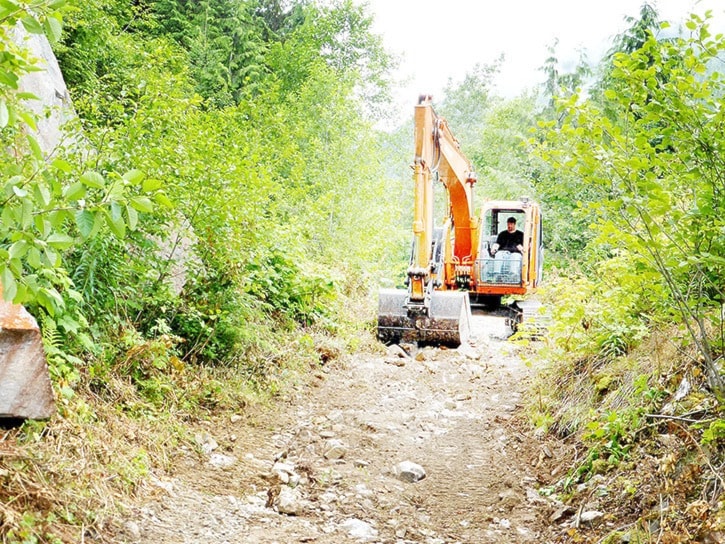Thanks to an excavator operator and a crew of volunteer brush-clearers, the route to two popular alpine hikes has been made a lot safer and simpler.
The project, led by the Hope Mountain Centre for Outdoor Learning, has shaved three kilometres — each way — off the hikes to the summits of Mount Wells and Mount Hope. Both peaks are accessed via the forest service road, which starts just east of the junction of Highways 3 and 5.
“The road bed was really eroded,” said Kelly Pearce, program director of Hope Mountain Centre. “There were some big, nasty boulders and some trees down — as well as saplings in the road bed, which had been cut back by a crew of eight volunteers a couple of weeks earlier.”
Traditionally, hikers could drive eight km up the road before parking at a landing and heading onto the trails.
“There was a really bad section at kilometre 5, so that would mean hiking an extra three kilometres each way on an ugly logging road,” said Pearce. “That would make it a lot less likely to get hiked.
“Mount Hope is such an iconic peak, it seemed almost immoral to not be able to hike it. These are two important trails.”
Keith Lasser, of Tri-West Contracting used an excavator with a variety of bucket styles and put a day and a half of work into the road renovation, aided by a few volunteers.
The Cascade Lower Canyon Community Forest, a three-way partnership of Yale First Nation, the District of Hope and the Fraser Valley Regional District, provided the project funding, said Pearce.
“Keith improved six kilometres of road and rebuilt the water bars from kilometre 1 to 6, so water won’t run down the road,” added Pearce. “There used to be one log bridge but now you can basically drive through the creek.”
He stressed that it’s strictly a four-wheel-drive road, though ATVs and motorcycles could also make it through. “Two-wheel-drives could do damage, spinning their tires and tearing up the road,” he said.
Drivers with wide or shiny vehicles may want to wait a while, to give volunteers time to clip back the scratchy alder and willow branches that crowd in from the sides in some sections. If you’ve got a “bush buggy” the road is yours, starting now.
“From the trailhead, Mount Hope is four kilometres, one way, with a 670-metre elevation gain,” said Pearce.
For a person of average physical fitness, set aside six hours for a day hike.
“Wells Peak is two-and-a-half kilometres one way, with a 680-metre elevation gain,” he said. “Both have similarly spectacular views, though Mount Hope has the view of Hope.
“Mount Hope is a fairly well-defined trail, while Wells Peak is a scramble up an open scree slope to the peak. You can hike them right into October, depending on where the snow line lies.
“People can definitely camp overnight,” added Pearce. “There are two tarns (alpine ponds) on Mount Hope that you can filter water from.
“In a nice weather window, it’s an amazing thing to see the sun set and rise from the top of Mount Hope,” said Pearce, who has camped there, tentless.
“And you know, Hope looks really beautiful at night — like a glittering jewel.”
